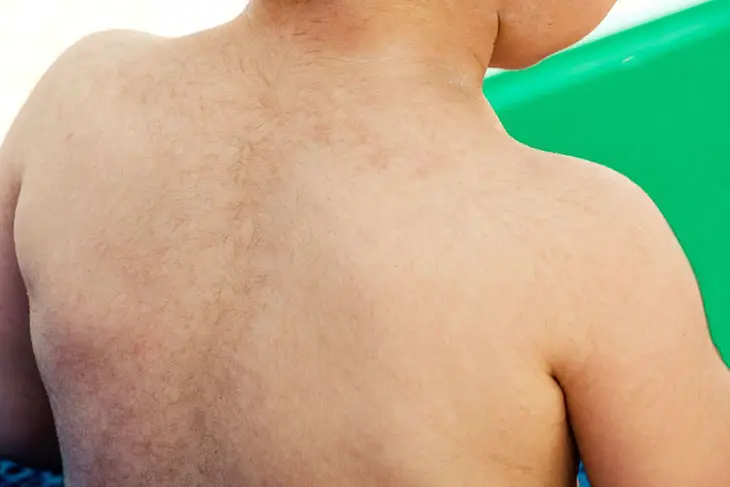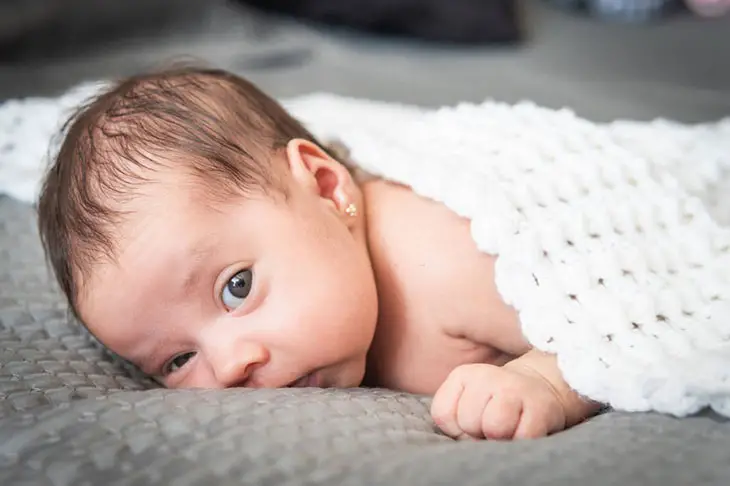My baby has hair on her privates, which worries me a lot. We have heard this problem many times. This condition is quite serious when it comes to lanugo.
It is a natural occurrence in infants and can be found in private areas.
While it concerns some parents, it is generally not a cause for alarm. However, excessive hair growth in infants can sometimes indicate an underlying medical condition.
This comprehensive article aims to provide you with all the information you need to know about hair in infants.
What Does Lanugo Hair Newborn Mean?

Lanugo hair is a natural condition in infants that can be found covering their bodies at birth. It especially happens in premature babies.
Lanugo is a soft, fine hair that develops in the fetus while inside the uterus. It provides warmth and protection as the babies grow.
The hair usually appears around 16 weeks of pregnancy and sheds around 36 weeks.
While it is not commonly found in newborns, its presence in premature infants is considered normal. The baby will loosen hair within the first few weeks of life.
However, lanugo can also develop in people with eating disorders or certain tumors.
Despite its association with these conditions, some lanugo hair in newborns is typically nothing to worry about.
However, too much hair growth in infants can sometimes indicate an underlying medical condition. You should take your children to a medical evaluation.
Is It Normal That My Baby Has Hair On Her Privates?
Many parents may wonder if it is normal for their baby to have hair in their private areas. The answer is yes; it is perfectly normal.
Lanugo hair can also be present on a newborn’s body. Infants born prematurely have more lanugo hair than full-term babies (39 weeks).
Lanugo hair is a natural part of fetal development. It serves several purposes, including temperature regulation, skin protection, and hormone regulation.
It is also worth noting that children or adults with eating disorders may develop lanugo hair due to their body’s difficulty keeping warm.
Meanwhile, some people with certain types of tumors may also grow lanugo hair.
Besides, excessive lanugo hair can indicate some health conditions. It can be because of genetic disorders, hormonal imbalances, metabolic disorders, and medication side effects.
Thus, when you see unusual signs of lanugo in your babies, you should take them to a doctor.
Also, don’t mistake lanugo hair for pubic hair. Though rare, it still happens in infants. This problem will be discussed later in the article.
Why Does My Baby Have Hair Down There?

Babies have lanugo hair as a natural part of their fetal development. It helps regulate their temperature, protects their skin, and controls hormones.
So, when you see lanugo on your baby, don’t panic.
Skin Protection
Lanugo hair is essential for safeguarding a baby’s skin when it is in the womb.
Vernix caseosa, greasy components, covers the baby’s skin, acting as a barrier against the amniotic fluid.
Lanugo hair connects to the vernix, which aids in its retention on the skin. The vernix may slip off the baby’s body if it doesn’t have hair to adhere to.
When a baby gets closer to their due date, they will need less lanugo, vernix, and protection. Therefore, overdue newborns have saggy, flaking skin, while some still retain lanugo hair.
Temperature Regulation
Lanugo hair also aids a developing kid in the womb with temperature regulation. The baby does not have a layer of fat or a large amount of body weight to keep them warm.
Lanugo development helps the infant control their temperature and retain heat.
It will keep them comfortable within the womb. Infants cannot manage their temperature until after delivery.
Thus, the hair acts as an insulating layer to maintain a constant temperature.
Hormonal Regulation
Lanugo hair may serve a function in hormone control in addition to regulating temperature and preserving the baby’s skin.
According to one theory, the lanugo hair movement on the baby’s skin may cause the production of hormones that alleviate stress.
These hormones may influence the baby’s metabolism, growth, and development.
While this is still a research in progress, it demonstrates the potential role of lanugo hair in baby development.
How To Remove Baby Lanugo Hair?
Special treatment is typically unnecessary if your premature baby or newborn has lanugo hair.
However, caring for your baby’s body hair is important to keep their delicate skin healthy and clean. Here are a few tips to help.
Be Patient
Allowing time for baby lanugo to vanish naturally is the best way to cure it. It is advisable to avoid intervening in the hair.
You should let it shed naturally. Your newborns may still need it for temperature regulation or other reasons.
Normally, the hair will fall out within a few days or weeks of delivery. In some exceptional cases, lanugo can last for much longer.
For ease of mind, you can consult your doctor when your babies retain lanugo for so long.
Don’t Use Hair Removers
It is important to avoid using any hair removal creams or other similar products, such as wax or shavers. These products are unsafe for infants and can potentially harm their delicate skin.
In case you have any concerns about your skin health, it is always best to consult your healthcare provider.
Gentle Massage
It is one of the most effective hair removal methods. Gently massaging the skin with moderate baby lotion or oil may induce natural lanugo hair loss.
However, you must proceed cautiously to prevent hurting your baby’s sensitive skin.
Using only safe and mild products on your baby’s eyes and skin is advisable to avoid irritation. Since they are small babies, your infants will need your close attention.
Avoid dressing your baby in mittens when there is unwanted hair on their hands. It may cause Hair Tourniquet Syndrome, which can limit blood supply and cause pain.
Doctors
If you have any concerns or hair questions about your baby’s lanugo hair, it is recommended to consult with your doctor.
They can reassure you and answer any questions about your baby’s hair growth.
They will also identify whether the hair is lanugo and guide babies’ health and well-being.
Is It Normal For A 7 Month Old To Have Pubic Hair?

Being 7 months old and having pubic hair is an uncommon phenomenon. A retrospective study was done on 11 babies’ hair before the age of 12 months.
There were 6 males and 5 females who presented to pediatric endocrine clinics. They had isolated pubic hair development during the previous five years.
The typical age at evaluation was 8 months. Most patients had pubic hair in an unusual area.
Besides, there are internet cases about pubic, underarm hair, and premature thelarche at < 12 months of age.
However, they do not show any other signs of puberty, like breast development in girls or testicular enlargement in boys.
Based on the findings of this study, it is indicated that isolated pubic hair or genital hair in infancy is a benign condition. The babies observed were all healthy infants.
However, continued monitoring is required to identify whether pubic hair in infancy is an unusual type of premature adrenarche (PA).
There is no assurance of no later adult illness. No research has been done to find the cause of babies with puberty and hormone imbalances.
The only well-understood condition is precocious puberty. It is the onset of puberty at the age of 8 years in girls and 9 years in boys.
Why Does My Baby Girl Have Pubic Hair?
The causes of pubic hair in babies are not well studied. She may be suffering from a disease known as early adrenarche, the awakening of the adrenal gland.
This disorder is characterized by the rapid growth of pubic hair at an early age, though it is normally not that young. An increase in adrenal hormone levels causes it.
However, the study above concluded this condition is a benign entity that will disappear, just like wrong-ordered teeth in babies.
Yet, there is no assurance for the later diseases at the onset of puberty. It is advisable that you take your children to a doctor for long-term follow-ups.
If your doctor is concerned, they may send you to an endocrinologist. They may conduct blood tests to discover the underlying reason for the early hormone increase.
When To Worry
There is no need to worry a lot. First, you need to identify whether axillary hair is really pubic hair or not.
When the hair resembles peach fuzz, it’s most likely not pubic hair. It should be vellus hair.
Besides, you may mistake pubic hair for lanugo hair, a more common hair in infants. Lanugo is soft, thin, and fuzzy hair, like a feather. The color may vary from light to dark hair.
Genetics will determine the dark or light color. Meanwhile, pubic hair typically appears curly, darker, and coarse hair growing in the pubic area.
Besides, the presence of lanugo hair in newborns is common. Nevertheless, once it does shed for a long time, it should be an alarm.
It may be a sign of several medical conditions. You should consult a healthcare provider when you notice the unusual symptoms.
Conclusion
If you’re concerned because “my baby has hair on her privates,” it is essential to understand that it is not uncommon for pubic hair in newborns. You should contact doctors.
However, when it comes to lanugo hair, it is common. In case it is excessive and lasts long, you can consult your healthcare provider.
